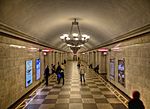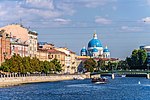The Anichkov Bridge (Russian: Аничков мост, Anichkov Most) is the oldest and most famous bridge across the Fontanka River in Saint Petersburg, Russia. The current bridge, built in 1841-42 and reconstructed in 1906-08, combines a simple form with some spectacular decorations. As well as its four famous horse sculptures (1849–50), the bridge has some of the most celebrated ornate iron railings in Saint Petersburg. The structure is mentioned in the works of Pushkin, Gogol, and Dostoevsky.
The first bridge was built in 1715-16 by order of Peter the Great, and named after its engineer, Mikhail Anichkov. The bridge was made of wood with several spans built on piles of supports lying just above the Fontanka River. It was designed by Domenico Trezzini. Nothing remains of this first bridge.
As the city grew and river traffic increased, plans were unveiled in 1721 to create a new drawbridge. The Anichkov Bridge was one of seven three-span stone drawbridges with towers built across the Fontanka River in the late 18th century, of which the Lomonosov Bridge and the Stary Kalinkin Bridge are the two still extant. At that time, the Anichkov Bridge was an especially popular attraction on Nevsky Prospekt, as well as a popular subject for illustrations and paintings.
By the 1840s the 18th-century design, especially its large towers, was deemed unsuitable for the growing amount of traffic passing over the Anichkov Bridge along Nevsky Prospekt. In 1841-42 a grander structure, more appropriate to the width of Nevsky Prospekt, was built on the site under the supervision of Lt. General A. D. Gotman. The new bridge was made of stone, and had three spans closed off with gently sloping arches. This simple, concise form corresponded well with the massive cast-iron fencing bordering Anichkov Bridge and mermaid cast-iron railings, originally designed by Karl Friedrich Schinkel for the Palace Bridge in Berlin. However, the bridge's stone arches were a continual source of problems, and in 1906-08 the bridge had once again to be reconstructed and its arches reinforced.












